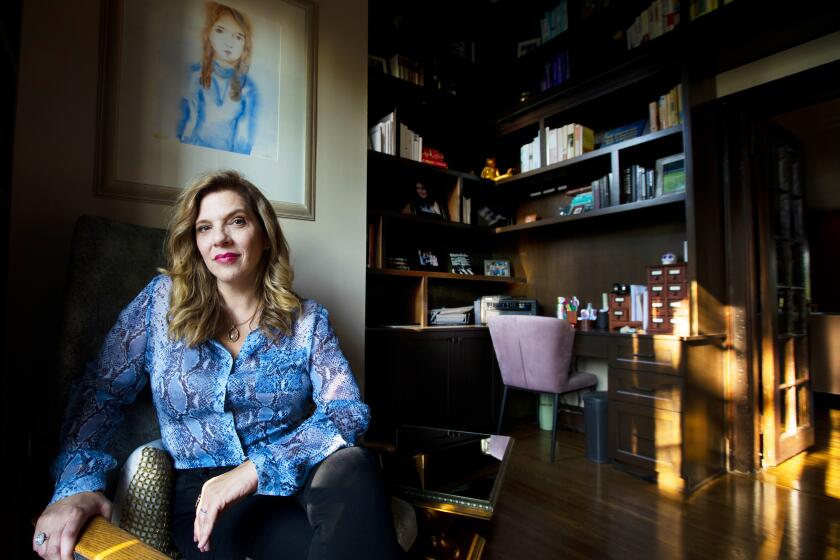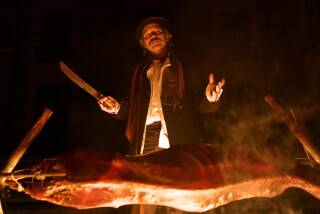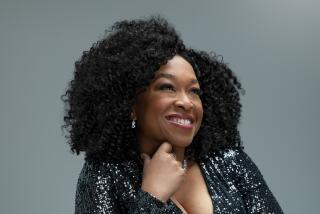Commentary: How two wildly different TV shows figured out how not to ignore a plague
“These strange times.”
The phrase appeared last March, much as a wildflower might: with sudden, almost gobsmacked abandon, born in preparation of its own demise.
Soon it came in many hues. In corporations’ hushed advertisements, saying times were “uncertain,” a temporary rest stop on the road back to growth. Columnists and cable news anchors preferred “unprecedented,” novelty being the content mill’s most efficient fuel. “It’s Always Sunny in Philadelphia” fans (and perhaps other poets) reached for “trying,” albeit in a satirical sense; the nostalgic longed for “the before”; and many of us, rendered inarticulate by the scale and speed of events, were reduced to the broadest of generalities: “in these times.”
A year later, the dictionary of the COVID-19 pandemic has come to include not only scientific terms — asymptomatic, positivity rate, community spread — and neologisms — covidiot, quaranteam, mascne — but a startling number of linguistic feints as well, repurposed for a disaster we in the U.S. proved unwilling, or unable, to look square in the eye.
“Now more than ever” emerged as self-parodic promotional copy for countless retailers, for instance, while former President Donald Trump faced the coronavirus death toll in August with a verbal shrug: “It is what it is.” The arm’s length of Latin led to a resurgence of annus horribilis. Even the phrases most closely associated with the pandemic itself — “grim milestone,” “social distancing,” “flatten the curve” — conveniently avoided naming the fears at the heart of the matter: sickness, suffering, debility, death.
If it is the informal language of the last 12 months that future generations will cite as evidence of our survival, then — like those newspaper clippings from 1918 now circulating on Twitter — it is euphemism that will define our defeat. How else to explain the curves that became spikes, the lockdowns that weren’t, the times that in fact had plenty of precedent, except to say that our powers of description failed us? To confront the truth is first to enunciate it, and on neither count was American society equal to the task. Hell, we made the very word “pandemic” a misnomer: No plague can be said to affect “all people” when Black and Latino people are dying at disproportionately high rates, anti-Asian hate crimes hit historic highs and affluent white communities escape largely unscathed.
Russell T Davies’ series, streaming on HBO Max, fails to reimagine the often moralizing and pathologizing treatment of HIV-positive people in pop culture.
It’s this need for crisp language and clear information that runs along the backbone of Russell T. Davies’ moving, prescient “It’s a Sin,” now streaming on HBO Max, which frames another epidemic in wrenchingly familiar terms. In its first episode, set in London in September 1981, young protagonist Ritchie Tozer (Olly Alexander) dismisses the “mystery illness” then circulating in San Francisco and New York: “You can’t have a gay flu,” he cries at an aging punk’s barroom warning. “And no one dies of flu anymore!”
From there, the series’ treatment of the AIDS crisis, though not without its shortcomings, doesn’t hesitate to depict the stigma, the discrimination, the misinformation and malfeasance that hastened the spread of HIV, slowed the response and ultimately contributed to the deaths of thousands in the U.K. alone. Activists, particularly Ritchie’s friend and occasional beard, Jill (Lydia West), emerge as the heroes of “It’s a Sin”: Their insistence on gathering, circulating and acting on knowledge about the disease propels much of the drama, from the search for news out of New York to a die-in on the doorstep of a British pharmaceutical company.
Too often tempted into the maudlin — notably in the closing minutes, as Jill dresses down Ritchie’s mother (Keeley Hawes), an ill-fitting symbol of Prime Minister Margaret Thatcher’s Britain — the series’ ferocious aversion to cant nonetheless inspires its most arresting interlude, a fourth-wall-breaking theatrical montage in which Ritchie, an aspiring actor, rehearses the denialist’s litany. It’s a racket, it’s a lie, it’s a rumor, it’s a nightmare, he proclaims; it’s caused by comets, scientists, Russians, God. At first, the assumption of this perspective seems out of place, disrupting the ensemble’s dramatic balance and progressive thrust, but read in the context of the entire series, its fantastical purpose becomes apparent. The scales can only fall from your protagonist’s eyes if he has blinders on in the first place.
As in Davies’ magnificent “Years and Years,” which turned on the rise of a right-wing populist with a zest for manipulating the media, the point here isn’t to condemn Ritchie or other ordinary people swayed by falsehoods. It’s to illustrate euphemism’s soothing allure and its dire consequences — especially via entertainment cloaked as information, opinion masquerading as fact. “No one knows anything,” Jill laments, as if to punctuate the point, later in the same episode. “There’s nothing in this entire country. There’s no information anywhere.”
The “Grey’s Anatomy” showrunner explains how they pulled off that season-opening shocker — and why Katherine Heigl didn’t get the sendoff fans wanted.
Meredith Grey (Ellen Pompeo) has no more patience for willful ignorance than Jill does, and 40 years, 5,000 miles, 350-plus episodes and an epidemic away from the action of “It’s a Sin,” the Seattle surgeon at the center of “Grey’s Anatomy” now dispatches her trademark voice-over with similar directness. “Wash your hands. Wear a mask. Stay six feet apart at all times,” she says early in the medical drama’s 17th season, which despite a handful of missteps has confronted the COVID-19 pandemic more forthrightly than perhaps any other network TV show.
“Grey’s,” which returns Thursday on ABC, hasn’t simply turned its hospital setting to its advantage. In the six episodes that aired between its November premiere and its winter hiatus, the series brings its venerable power to bear on COVID as surely as Davies applies his melodramatic instincts to AIDS, immersing viewers in conversations about ventilators and PPE, nursing homes and power of attorney, isolation, racism and grief. Even its most heightened language inveighs against euphemism: “I want to be in the before,” former chief Richard Webber (James Pickens Jr.) tells the terrified new intern class. “But the before is gone. We’re in the now, and people are looking to us to guide them through it.”
More impressive, though, is the series’ use of its prime place in the cultural firmament to underscore the point. Stricken with COVID in the two-hour premiere, Meredith has spent much of the season so far confined to her hospital bed, drifting in and out of consciousness, suffering seizures and chills, undergoing experimental treatments, indeed facing death itself — strolling a heavenly beach with the dearly departed of “Grey’s Anatomy’s” long annals, including an old flame (Patrick Dempsey’s McDreamy) and an old friend (T.R. Knight’s George).
Stunt casting, sweeps-style plotting, poignant pop cues: In repurposing the techniques of the prime-time soap to dramatize the frontline battle against COVID, all at the height of the holiday surge, “Grey’s” counters the much-discussed desire for escape, on TV and otherwise, with a demand to pay attention, to call it as we see it, to name — and face — our fears.
In the new Apple docuseries “Visible: Out on Television,” the decades-long fight for LGBTQ representation on TV is only just beginning.
Perhaps I’m a Pollyanna to say so, but if TV is capable of lulling us to sleep, keeping us company, transporting us to distant lands, its influence also can be made to upset the complacent, to draw out the truth, maybe especially in the guise of its most sugared confections.
After all, before he thrusts himself into the path of a policeman’s baton to protect Jill, Ritchie’s political education, at the hands of funeral protesters and his friend, roommate and lover, Ash (Nathaniel Curtis), culminates in 1988, when an exchange on the set of the sci-fi adventure “Doctor Who” finally persuades him to get tested for HIV. That Davies himself resurrected “Who” in 2005 isn’t the allusion’s only heartfelt resonance, though. The entry in question, featuring the Doctor’s most merciless foe, is “Remembrance of the Daleks” — a tribute, Davies has said, to actor Dursley Linden, who appeared in the episode, became an ardent activist after his own diagnosis and died from AIDS in 1995.
All times are strange, you see, to those who live through them and die in them; it’s why history is strewn with proper nouns one might find in a fairy tale — the princes in the tower, the Crystal Palace, the Iron Curtain, the Hundred Years’ War. Much harder is forcing yourself, in times full of fairy tales in their myriad forms, to acknowledge that “strange” and “uncertain” and “unprecedented” have not and may never begin to match the uncomfortable truth of the matter: that the future’s disaster fiction will be about us.
‘It's a Sin’
Where: HBO Max
When: Any time
Rating: TV-MA (may be unsuitable for children under the age of 17 with advisories for coarse language and sexual content)
‘Grey's Anatomy’
Where: ABC
When: 9 p.m. Thursday
Rating: TV-14-S (may be unsuitable for children under the age of 14 with an advisory for sexual content)
More to Read
The complete guide to home viewing
Get Screen Gab for everything about the TV shows and streaming movies everyone’s talking about.
You may occasionally receive promotional content from the Los Angeles Times.








